-
 Bitcoin
Bitcoin $106,731.2224
-1.05% -
 Ethereum
Ethereum $2,444.9804
-1.20% -
 Tether USDt
Tether USDt $1.0003
0.01% -
 XRP
XRP $2.1882
0.09% -
 BNB
BNB $651.1435
-0.61% -
 Solana
Solana $148.3252
-2.09% -
 USDC
USDC $1.0000
0.01% -
 TRON
TRON $0.2787
0.55% -
 Dogecoin
Dogecoin $0.1598
-3.16% -
 Cardano
Cardano $0.5520
-2.43% -
 Hyperliquid
Hyperliquid $39.0960
-2.64% -
 Bitcoin Cash
Bitcoin Cash $516.9519
2.98% -
 Sui
Sui $2.7011
-2.95% -
 Chainlink
Chainlink $13.0582
-1.71% -
 UNUS SED LEO
UNUS SED LEO $8.9250
-2.53% -
 Stellar
Stellar $0.2359
-0.18% -
 Avalanche
Avalanche $17.3856
-3.73% -
 Toncoin
Toncoin $2.8095
-3.56% -
 Shiba Inu
Shiba Inu $0.0...01121
-1.95% -
 Litecoin
Litecoin $85.2795
-0.85% -
 Hedera
Hedera $0.1471
-2.15% -
 Monero
Monero $319.8004
1.12% -
 Dai
Dai $1.0001
0.01% -
 Ethena USDe
Ethena USDe $1.0001
0.02% -
 Bitget Token
Bitget Token $4.5344
-1.07% -
 Polkadot
Polkadot $3.3224
-2.96% -
 Uniswap
Uniswap $6.9697
-2.75% -
 Aave
Aave $266.1658
-2.25% -
 Pepe
Pepe $0.0...09414
-3.41% -
 Pi
Pi $0.4913
-3.29%
Should we take profits if the weekly line has large volume stagnation + the daily RSI top divergence?
Weekly volume stagnation and daily RSI top divergence signal weakening momentum and potential price reversals in crypto markets.
Jul 01, 2025 at 05:22 pm
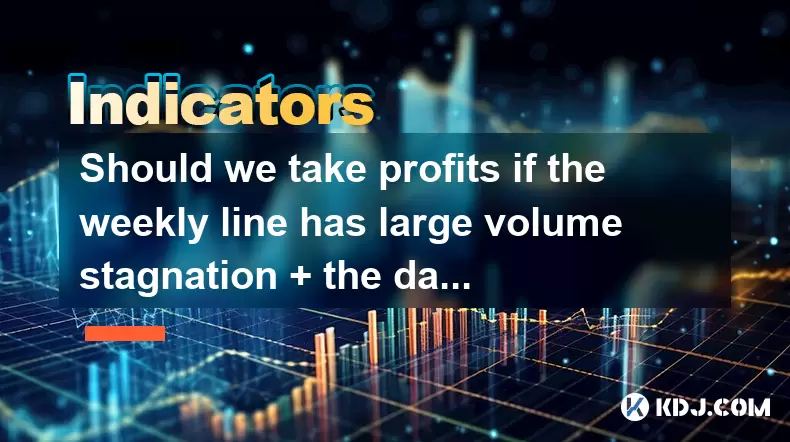
Understanding Weekly Volume Stagnation in Cryptocurrency Trading
In cryptocurrency trading, weekly volume stagnation refers to a situation where the total trading volume over a week remains relatively flat or shows no significant increase despite price movements. This phenomenon can indicate that institutional or large traders are not actively participating in the market at that level.
When this occurs alongside a lack of upward momentum in price, it often signals that there may be a supply wall forming or that buyers are hesitant to push the price higher. Traders should pay attention to whether the price is approaching a key resistance level while volume fails to expand, as this could suggest an impending reversal or consolidation phase.
Daily RSI and Top Divergence: What It Means for Traders
The Relative Strength Index (RSI) is a widely used momentum oscillator that measures the speed and change of price movements. When applied on a daily chart, it helps identify overbought or oversold conditions.
A daily RSI top divergence happens when the price makes a new high, but the RSI does not confirm this by making a corresponding high. This divergence indicates weakening momentum and potential exhaustion in the current uptrend. For example, if Bitcoin hits $70,000 but the RSI peaks lower than its previous high, it suggests that fewer buyers are willing to enter at higher prices.
This kind of divergence is considered a bearish signal and is often used by experienced traders as a reason to consider taking partial profits or tightening stop-loss orders.
Combining Weekly Volume Stagnation with Daily RSI Divergence
When both weekly volume stagnation and daily RSI top divergence occur simultaneously, they form a confluence of signals that many technical analysts view as a strong warning sign. The combination implies that the market lacks conviction from big players (volume stagnation) and that the momentum behind the price rally is fading (RSI divergence).
Traders who rely on technical indicators often interpret this as a time to reduce exposure or secure some gains. However, it's important to note that these signals do not guarantee a reversal — they merely highlight increased risk in holding positions through such setups.
To better understand how these two factors interact, consider the following:
- Price continues to rise while RSI begins to decline, signaling waning bullish energy.
- Volume on weekly charts remains flat, suggesting that even though the price might look strong, the underlying demand isn't growing.
How to Identify These Patterns on Charts
To effectively spot weekly volume stagnation, you need to compare the volume bars across multiple weeks. Look for:
- Weeks where the price climbs significantly, but the volume bar doesn’t stand out compared to previous weeks.
- Weeks where volume appears compressed despite volatile price swings.
For identifying daily RSI top divergence, follow these steps:
- Plot the RSI indicator (usually set at 14 periods) on the daily chart.
- Draw trendlines connecting the RSI highs and compare them with the price trendlines.
- If the price trendline is ascending while the RSI trendline is descending, a top divergence is confirmed.
Using tools like TradingView or Binance’s native charting platform can help visualize these patterns clearly. You can also enable alerts for specific RSI levels or volume thresholds to stay informed without constantly monitoring your screen.
Strategic Profit-Taking Approaches Based on These Signals
If you're managing a position in a cryptocurrency that exhibits both weekly volume stagnation and daily RSI top divergence, several profit-taking strategies can be employed:
- Partial Take-Profit Orders: Set take-profit levels at key resistance zones or Fibonacci extensions. Even if the price continues to move higher after triggering part of your order, you’ve already locked in some gains.
- Trailing Stop-Loss: Use a trailing stop to protect profits dynamically. As the price rises, the stop-loss follows it up, giving the trade room to breathe while protecting against sudden reversals.
- Time-Based Exits: Consider exiting portions of your position based on time rather than just price. For instance, exit one-third of your position every few days if the price hasn't broken out strongly.
It's crucial to avoid emotional decision-making during such moments. Having a predefined trading plan that includes rules for exiting under certain technical conditions will help maintain discipline.
Examples and Historical Cases in Crypto Markets
Historically, there have been several instances where weekly volume stagnation and daily RSI top divergence coincided before major pullbacks in crypto markets. For example, during late 2021, Ethereum showed signs of both signals before dropping from around $4,800 to below $3,000 within a month.
Another case occurred with Solana in early 2022, where despite price climbing to all-time highs, the volume failed to keep pace and RSI diverged sharply. Within weeks, the token corrected over 40%.
These examples highlight the importance of combining multiple technical signals rather than relying on any single indicator. They also show that even strong bull moves can end abruptly when momentum fades and institutional interest stalls.
Frequently Asked Questions
Q: Can volume stagnation happen in a downtrend?
Yes, volume stagnation can occur in both uptrends and downtrends. In a downtrend, it may indicate a lack of selling pressure, potentially signaling a bottoming process. However, in the context of this article, we focus on stagnation during uptrends as a possible reversal sign.
Q: Is RSI divergence always reliable?
No indicator is 100% accurate. RSI divergence can produce false signals, especially in highly volatile or illiquid markets. It's best used in conjunction with other tools like moving averages, candlestick patterns, or volume analysis.
Q: How long should I wait before acting on these signals?
There's no fixed timeline. Some traders act immediately upon confirming both signals, while others wait for a breakdown below key support levels. It depends on your risk tolerance and trading style.
Q: Should I close my entire position if both signals appear?
Not necessarily. Many traders prefer to reduce exposure gradually. For example, closing half the position initially and then adjusting the rest based on further price action.
Disclaimer:info@kdj.com
The information provided is not trading advice. kdj.com does not assume any responsibility for any investments made based on the information provided in this article. Cryptocurrencies are highly volatile and it is highly recommended that you invest with caution after thorough research!
If you believe that the content used on this website infringes your copyright, please contact us immediately (info@kdj.com) and we will delete it promptly.
- Deutsche Bank's Bitcoin Custody Play: A New York Minute on Crypto Services
- 2025-07-01 22:30:12
- ZachXBT, Ripple, and RLUSD Adoption: A Deep Dive
- 2025-07-01 22:30:12
- Open XP Redemption on Optimism: Get Ready for OP Tokens on July 15!
- 2025-07-01 22:35:12
- Altcoins in June 2025: Data, Trends, and What's Next for Crypto
- 2025-07-01 21:30:12
- SUI Price Breakout Watch: Will 2025 Forecasts Hit the Mark?
- 2025-07-01 21:30:12
- BTCBULL: Riding Bitcoin's Bull Run to Crypto Glory
- 2025-07-01 20:30:11
Related knowledge
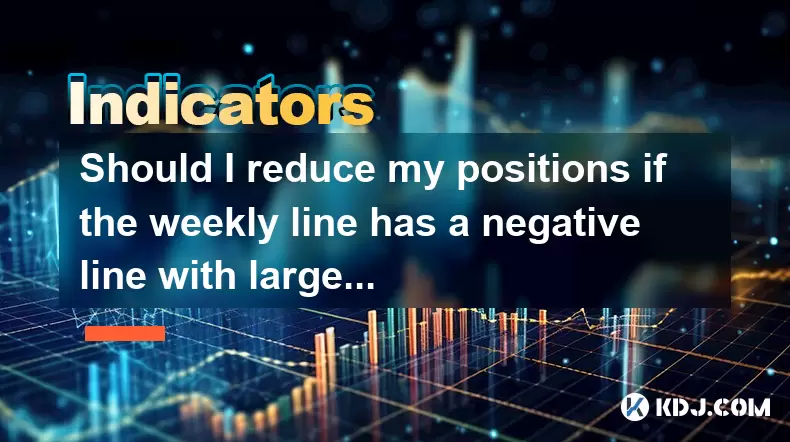
Should I reduce my positions if the weekly line has a negative line with large volume + the daily line falls below the middle Bollinger line?
Jul 01,2025 at 10:50pm
Understanding the Weekly Line with Negative Candle and Large VolumeWhen analyzing cryptocurrency charts, a weekly line that forms a negative candle accompanied by large volume is often interpreted as a strong bearish signal. This pattern suggests that institutional or large traders are actively selling their positions, which can foreshadow further price...
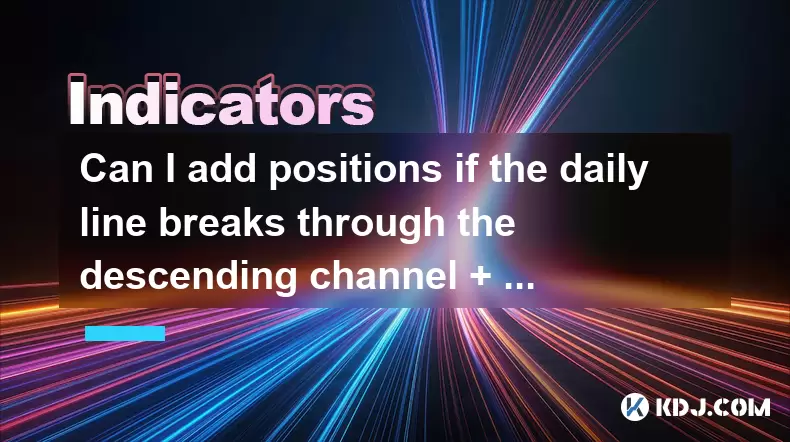
Can I add positions if the daily line breaks through the descending channel + the 30-minute moving average is in a bullish arrangement?
Jun 30,2025 at 11:00pm
Understanding the Descending Channel BreakoutWhen a daily line breaks through a descending channel, it indicates a potential shift in market sentiment from bearish to bullish. A descending channel is formed by drawing two parallel trendlines, where the upper trendline connects the lower highs and the lower trendline connects the lower lows. A breakout o...

Should we take profits if the weekly line has large volume stagnation + the daily RSI top divergence?
Jul 01,2025 at 05:22pm
Understanding Weekly Volume Stagnation in Cryptocurrency TradingIn cryptocurrency trading, weekly volume stagnation refers to a situation where the total trading volume over a week remains relatively flat or shows no significant increase despite price movements. This phenomenon can indicate that institutional or large traders are not actively participat...
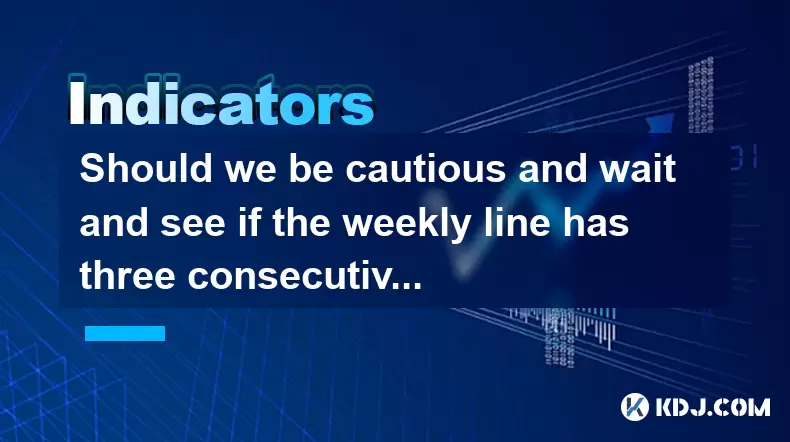
Should we be cautious and wait and see if the weekly line has three consecutive Yin lines + the daily MACD green column enlarges?
Jul 01,2025 at 12:42am
Understanding the Weekly Three Consecutive Yin Lines PatternIn technical analysis, three consecutive Yin lines on a weekly chart indicate a strong bearish trend. Each Yin line represents a week where the closing price is lower than the opening price, signaling consistent selling pressure. When this pattern appears three times in succession, it often sug...
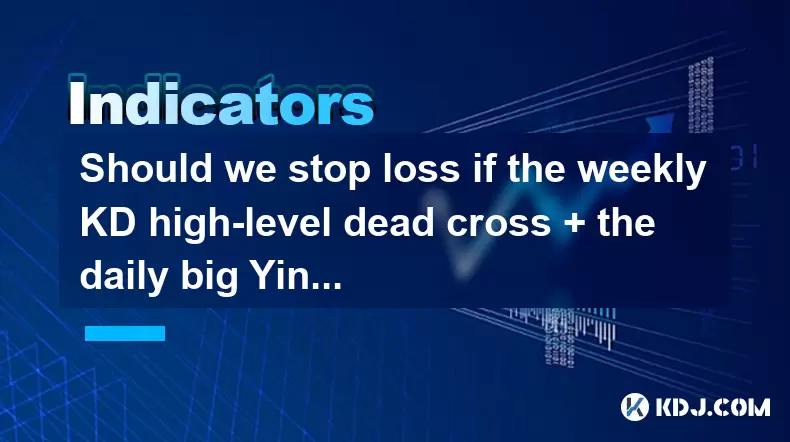
Should we stop loss if the weekly KD high-level dead cross + the daily big Yin line breaks?
Jul 01,2025 at 09:49pm
Understanding the Weekly KD High-Level Dead CrossIn technical analysis, KD (K-D indicator) is a momentum oscillator that helps traders identify overbought or oversold conditions in the market. The weekly KD high-level dead cross occurs when both the K-line and D-line are above 80 (indicating overbought territory), and the K-line crosses below the D-line...
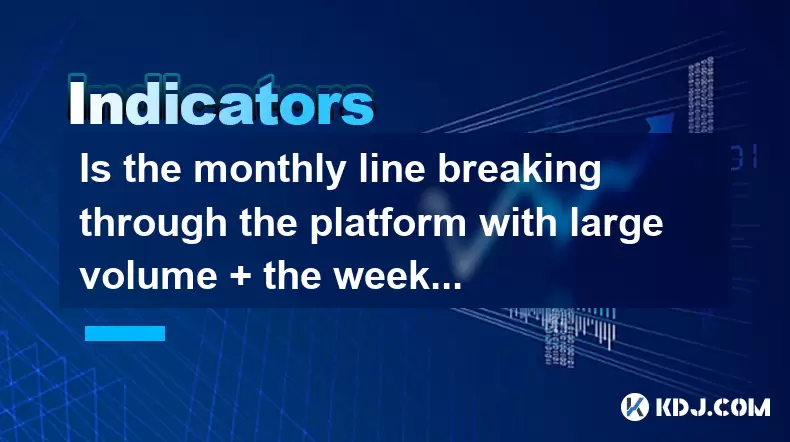
Is the monthly line breaking through the platform with large volume + the weekly moving average converging and then diverging and bullish?
Jul 01,2025 at 05:01pm
Understanding Monthly Line Breakouts in CryptocurrencyIn the world of cryptocurrency trading, monthly line breakouts are significant events that can indicate long-term trends. When a cryptocurrency's price breaks above a key platform or consolidation zone on the monthly chart, especially with large volume, it often signals strong institutional or whale ...

Should I reduce my positions if the weekly line has a negative line with large volume + the daily line falls below the middle Bollinger line?
Jul 01,2025 at 10:50pm
Understanding the Weekly Line with Negative Candle and Large VolumeWhen analyzing cryptocurrency charts, a weekly line that forms a negative candle accompanied by large volume is often interpreted as a strong bearish signal. This pattern suggests that institutional or large traders are actively selling their positions, which can foreshadow further price...

Can I add positions if the daily line breaks through the descending channel + the 30-minute moving average is in a bullish arrangement?
Jun 30,2025 at 11:00pm
Understanding the Descending Channel BreakoutWhen a daily line breaks through a descending channel, it indicates a potential shift in market sentiment from bearish to bullish. A descending channel is formed by drawing two parallel trendlines, where the upper trendline connects the lower highs and the lower trendline connects the lower lows. A breakout o...

Should we take profits if the weekly line has large volume stagnation + the daily RSI top divergence?
Jul 01,2025 at 05:22pm
Understanding Weekly Volume Stagnation in Cryptocurrency TradingIn cryptocurrency trading, weekly volume stagnation refers to a situation where the total trading volume over a week remains relatively flat or shows no significant increase despite price movements. This phenomenon can indicate that institutional or large traders are not actively participat...

Should we be cautious and wait and see if the weekly line has three consecutive Yin lines + the daily MACD green column enlarges?
Jul 01,2025 at 12:42am
Understanding the Weekly Three Consecutive Yin Lines PatternIn technical analysis, three consecutive Yin lines on a weekly chart indicate a strong bearish trend. Each Yin line represents a week where the closing price is lower than the opening price, signaling consistent selling pressure. When this pattern appears three times in succession, it often sug...

Should we stop loss if the weekly KD high-level dead cross + the daily big Yin line breaks?
Jul 01,2025 at 09:49pm
Understanding the Weekly KD High-Level Dead CrossIn technical analysis, KD (K-D indicator) is a momentum oscillator that helps traders identify overbought or oversold conditions in the market. The weekly KD high-level dead cross occurs when both the K-line and D-line are above 80 (indicating overbought territory), and the K-line crosses below the D-line...

Is the monthly line breaking through the platform with large volume + the weekly moving average converging and then diverging and bullish?
Jul 01,2025 at 05:01pm
Understanding Monthly Line Breakouts in CryptocurrencyIn the world of cryptocurrency trading, monthly line breakouts are significant events that can indicate long-term trends. When a cryptocurrency's price breaks above a key platform or consolidation zone on the monthly chart, especially with large volume, it often signals strong institutional or whale ...
See all articles

























































































